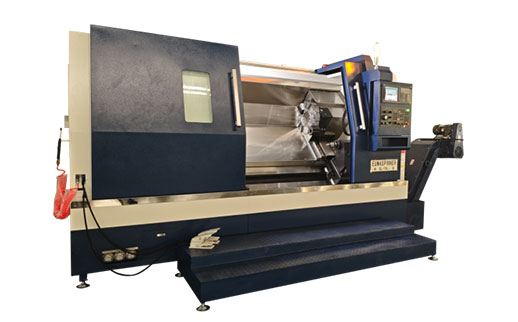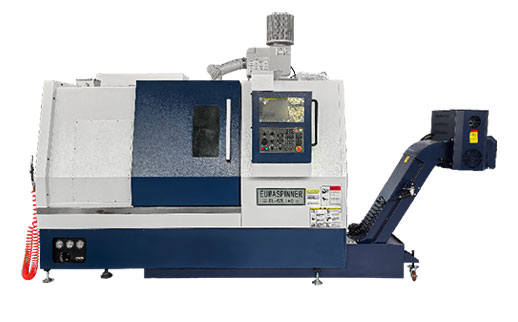In the era of smart manufacturing, CNC (Computer Numerical Control) machines have become the core equipment for precision machining in industries such as aerospace, automotive, mold making, and electronics. Their ability to achieve high-precision, automated, and multi-process machining relies entirely on the coordinated operation of key components. For manufacturers, operators, and procurement teams, understanding the 7 major parts of a CNC machine is critical to optimizing production efficiency, reducing maintenance costs, and selecting the right equipment for specific needs. Today, we break down each core component, its function, and its role in ensuring stable, high-quality machining.
.jpg)
5-Axis Machining Center (A/C axis)
1. CNC Control Unit: The "Command Brain" of Precision Machining
As the central nervous system of a CNC machine, the CNC Control Unit directly determines the machine’s responsiveness, accuracy, and operational flexibility—making it a top focus for businesses seeking consistent machining results.
- Interprets machining programs (G-code, M-code) input via USB, network, or manual data input (MDI), converting digital instructions into actionable electrical signals.
- Enables real-time monitoring: Tracks axis position, spindle speed, tool wear, and temperature, triggering alarms for abnormalities (e.g., overtravel, overload) to avoid costly downtime.
- Supports parameter customization: Allows operators to adjust feed rates, spindle speeds, and error compensation settings for different materials (aluminum, steel, titanium) and processes (milling, turning, drilling).
- SEO-Focused Advantages: Integrates with leading industrial systems (Fanuc 0i-MF, Siemens Sinumerik 828D) to reduce human error, a key demand for “CNC machine precision control” searches.
- Application Case: A mold factory using a high-end CNC control unit reduced machining errors by 30% when producing complex plastic injection molds, cutting rework time significantly.
2. Machine Tool Structure: The "Stable Skeleton" for Heavy-Duty Operations
The Machine Tool Structure is the foundation that supports all components, and its rigidity, vibration resistance, and thermal stability directly affect machining precision—especially for large or heavy workpieces.
- Bed: Made of high-strength cast iron or granite (for ultra-precision machines) to absorb vibration and prevent deformation during high-speed cutting.
- Column: A vertical frame that holds the spindle unit, reinforced with ribbed designs to withstand cutting forces in heavy-duty applications (e.g., aerospace part machining).
- Worktable & Saddle: The worktable secures workpieces via clamps or chucks, while the saddle drives smooth movement along X/Y axes using linear guides—critical for “CNC machine stable positioning” needs.
- Industry Relevance: For manufacturers searching “CNC machine for large parts,” a robust structure ensures no bending or shifting, even when machining 10-ton aerospace components.
3. Servo Drive System: The "Precision Muscle" for Axis Movement
The Servo Drive System acts as a bridge between the CNC Control Unit and mechanical parts, converting electrical signals into precise motion—making it essential for “CNC machine high-accuracy positioning” searches.
- Servo Drive: Amplifies low-voltage signals from the CNC unit to power the servo motor, adjusting current in real time for smooth operation.
- Servo Motor: AC servo motors (or torque motors for heavy loads) with encoder feedback, enabling closed-loop control to correct deviations (positioning accuracy up to ±0.001 mm).
- Practical Benefits: Reduces mechanical shock during rapid axis movement, improving workpiece surface finish and extending tool life—addressing the “CNC machine surface quality” pain point for automotive part manufacturers.
- Example: A high-speed CNC milling machine with a 3,000 rpm servo motor cuts aluminum parts 20% faster than traditional machines, thanks to quick acceleration/deceleration.
4. Spindle Unit: The "Cutting Powerhouse" for Material Removal
The Spindle Unit drives cutting tools (or workpieces in lathes) to rotate, generating the force needed for material removal—making it a key factor in “CNC machine cutting efficiency” and “tool life” searches.
- Spindle Motor: AC motors with variable frequency drives (VFD) for adjustable speeds (50–40,000 rpm): low-speed (50–5,000 rpm) for steel cutting, high-speed (10,000+ rpm) for aluminum/plastic.
- Precision Bearings: Angular contact ball bearings reduce runout (≤0.003 mm), ensuring consistent cuts and longer tool life.
- Cooling System: Oil/air cooling prevents overheating, critical for “CNC machine long-hour operation” in mass production.
- Application Impact: A 50 kW spindle unit in a heavy-duty CNC lathe can machine large steel shafts in half the time of a 20 kW unit, ideal for “CNC machine for heavy cutting” needs.
5. Feed System: The "Smooth Navigator" for Programmed Paths
The Feed System works with the servo drive to control linear/rotational movement along machine axes (X/Y/Z for milling, X/Z for lathes), ensuring tools follow programmed paths accurately—essential for “CNC machine multi-axis interpolation” searches.
- Ball Screw: Converts rotational motion to linear motion with low backlash (≤0.005 mm) and 90%+ efficiency, eliminating positioning errors.
- Linear Guideway: Reduces friction for smooth movement, even at high speeds (up to 60 m/min), supporting “CNC machine high-speed machining” demands.
- Coupling: Compensates for minor misalignment between servo motors and ball screws, avoiding vibration that harms precision.
- Real-World Use: A CNC router with a high-quality feed system can cut complex curved surfaces (e.g., furniture molds) with consistent accuracy, meeting “CNC machine for mold making” requirements.
6. Tool Magazine & Automatic Tool Changer (ATC): The "Efficient Tool Manager"
For multi-process machining (milling + drilling + tapping), the Tool Magazine and Automatic Tool Changer (ATC) automate tool storage and switching—addressing “CNC machine production efficiency” and “reducing setup time” searches.
- Tool Magazine: Stores 10–120 tools (drum-type for small machines, chain-type for high-volume production), compatible with standard tool holders (CAT40, BT30).
- ATC: Mechanical arms/shuttles with tool recognition (RFID/barcode) for fast changes (1–5 seconds), minimizing non-cutting time.
- SEO-Focused Value: Enables “unmanned CNC machining” for 24/7 production, a top demand for manufacturers searching “CNC machine for mass production.”
- Case Study: An automotive parts factory using an ATC-equipped CNC machine reduced tool change time by 80%, increasing daily output from 500 to 700 parts.
7. Auxiliary Systems: The "Supporting Infrastructure" for Safe, Continuous Operation
Auxiliary systems are non-core but critical for “CNC machine reliability” and “operator safety”—key terms for businesses prioritizing long-term productivity.
- Cooling System: Uses cutting fluid to cool tools/workpieces, reduce friction, and flush chips—vital for “CNC machine tool life extension.”
- Lubrication System: Automatically lubricates ball screws/linear guides, preventing wear and reducing maintenance costs.
- Chip Removal System: Conveyors/augers remove metal chips, avoiding interference with cutting (critical for “CNC machine for metal machining”).
- Safety System: Emergency stops, door interlocks, and overload protectors comply with industry standards (ISO 13849), addressing “CNC machine safety compliance” searches.
Why Understanding These 7 Parts Matters for Your Business
Every component of a CNC machine works in synergy: A weak spindle unit undermines even the best control system, while a poor feed system wastes high-precision tools. For manufacturers:
- Selection: Choose machines with components matching your needs (e.g., high-speed spindle for aluminum, robust structure for heavy parts).
- Maintenance: Targeted checks (e.g., servo motor encoder calibration, spindle bearing lubrication) reduce breakdowns.
- Efficiency: Optimize components (e.g., upgrade ATC for faster changes) to boost output without sacrificing quality.
Wenzhou EUMA Machinery Co., Ltd., a trusted partner in the CNC industry, offers customized solutions—from component upgrades to complete machine options—to help you maximize your productivity by leveraging these seven components. Contact our team today to learn how to optimize your CNC setup for your specific machining needs.If you want to know more about CNC, you can contact EUMA Machinery, we can provide effective help


